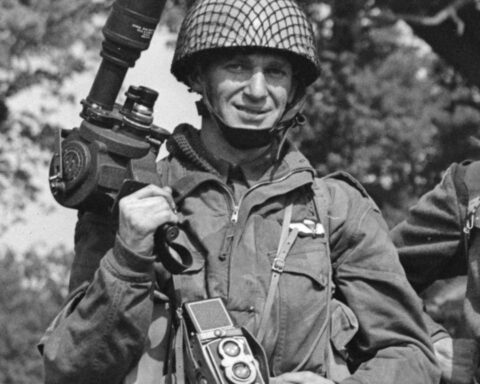PHOTO ABOVE: Major David V. Currie (left, with pistol in hand) of The South Alberta Regiment accepting the surrender of German troops at St. Lambert-sur-Dives, France, 19 August 1944. Major Currie was awarded the Victoria Cross for his leadership during the Canadian attack on the village. Credit: Lieut. Donald I. Grant / Canada. Dept. of National Defence / Library and Archives Canada / PA-111565. Restrictions on use: Nil. Copyright: Expired. Sgt. Jack Stollery can be seen at the far left filming Major David Currie in the act of winning the Victory Cross.

My photographer friend was a WW II hero.
By JEFF MAGUIRE
Originally written Dec 8, 2011
In recent years I have dedicated myself to telling the stories of Canada’s men and women in uniform during the wars of the 20th Century. I’ve always been interested in war-related history. But the older I get the more significant the world wars and Canada’s role in them, are for me. As a writer I’m determined to document the stories of as many service people as possible, living or dead. They put their lives on the line for the very best cause I can think of – the freedom of themselves and their fellow citizens!
To close out this year I have the honour of writing about someone who was a personal friend. We were in the same profession and he was a mentor to me and many other young reporter/photographers in the early 1970s. I knew he was overseas during WW II and that he took his considerable photographic skills with him. But like so many veterans my friend seldom talked about his war-time experiences. He saw too much and most was too painful to recall.
It was by pure chance that I found out recently just how important his contribution was to this country’s military history. My late friend was a true Canadian war hero! He was armed with a camera, not a rifle. However, his actions during battle earned him the Military Medal for bravery. His name is Jack Stollery and he was one of the finest men it has ever been my pleasure to know. Jack was from St. Thomas, Ontario (south of London) the city where I really launched my 40-year newspaper career in 1971. I worked at the daily St. Thomas Times-Journal (the T.J. as I’ve always called it) for nearly five years.
For a young reporter and a budding photographer like me, Jack was the perfect person to learn from. He had seen it all during his career. As it turns out much more than I had ever imagined! It would take several columns to tell you even part of what this wonderful man meant to me and so many other young journalists. The true stories he told us were incredible. Only a select few related to his war experiences and those were usually funny tales. The things he preferred to remember and reminisce about.
Jack taught me a great deal about life, work and the true meaning of friendship. He was always there for us and his calm demeanor and life’s experience were of great assistance to those of us working in the pressure-packed daily newspaper business. Jack and his brother Bill once did all of the news photography for the T.J. But by the time I arrived in St. Thomas Jack was operating his own photography business and studio. It was located upstairs in a commercial building directly across Hincks Street from the newspaper.
Near the end of his life he was appointed Deputy Sheriff of Elgin County, an appointment that reflected his political leanings. But Jack was well suited to the task. On Aug. 27 1974 he died suddenly at home of a massive heart attack. All who knew him were shocked and saddened. Jack was just 57. He left his wife Florence, brother William and two nephews. The Stollerys never had children. But they both loved young people. They were very good to Kathleen and me and so many others.
Major surprise
In 1976 we moved to Carleton Place where I continued my career, this time as an editor in the community newspaper business. I have never forgotten my late friend and mentor Jack Stollery. But as life went on and so much change occurred, that chapter in our lives slowly faded from my memory. Imagine my shock when last month (Nov. 20) I suddenly heard the name “Jack Stollery” while watching a documentary on TV Ontario. The film is called ‘Shooters’ and it’s subtitled “The Amazing WW II Adventures of the Canadian Army Film and Photo Unit.” The 2004 documentary was written, produced and directed by James O’Regan whose late father Brian (1924-1999) was a dispatch and Jeep driver attached to the Canadian Army Film and Photo Unit (CFPU). The film is dedicated to his father. I was surprised to discover that like me, James O’Regan is a native of Ottawa. We were born the same year, four months apart.
It was by pure chance that I came across Shooters and we watched it. TVO aired the documentary as part of their tribute to Canada’s military surrounding Remembrance Day. Late in the nearly 50-minute film there is a sequence about Canadian Major David Vivian Currie who won the Victoria Cross (VC), the British Commonwealth’s highest award for bravery during war-time, in France in August 1944. The narrator noted that “Sergeant Jack Stollery” was part of a four-man CFPU team who documented the incident. It was the first time the action leading to the awarding of a VC was captured on film. “Still photos were taken by Lieutenant Donald I. Grant and cine (motion picture) film by Sgt. Jack Stollery,” the production notes. Kathy and I looked at each other. “Sgt. Jack Stollery,” I said. “Could that be Jack Stollery from St. Thomas?” We immediately agreed that it had to be. “He was in the war and he was a photographer,” I said. “Besides, there is only one Jack Stollery!”
My subsequent research for this column was both interesting and rewarding. I was able to obtain Jack’s complete newspaper obituary which appeared in the T.J. at the time of his untimely passing in 1974. A big “thank you” to the good people at Elmdale Memorial Park in St. Thomas (the cemetery where Jack is interred) for that! He went overseas with the Elgin Regiment based in St. Thomas. But after arriving in England in 1942 Jack was transferred to the CFPU which had been founded in 1941 in order to document military operations during WW II. Among the campaigns the CFPU followed were the invasion of Sicily, the Italian campaign, the D-Day landings, the liberation of Paris and the Elbe River link-up of Allied armies. Initially only a handful of people were involved in the photo unit. By the end of the war 59 Canadian photographers and camera men had been directly involved in combat operations in Europe. Six of them were killed in action and 18 wounded. Remember their “weapons” were cameras, not rifles or machine guns. If anything they might carry a sidearm (pistol) in certain situations. Much of the time they had no weapons with which to defend themselves.
Vital record
Their work is impressive and a vital part of the historical record of the war. In fact the CFPU’s D-Day footage (in Normandy, France on June 6, 1944) was the first to be seen by such war-time leaders as Winston Churchill and Franklin D. Roosevelt. Most of the American footage recorded that day was destroyed as it turned out! My friend Jack was wounded twice while covering Canadian troops in action at Falaise (Normandy) in 1944 and later in Belgium. But it was on December 21, 1943 (68 years ago this month) at Ortona in Italy, while carrying out his duties as a photographer accompanying the forward units of the Canadian Army, that Jack won the Military Medal.
The record of the Army Film and Photo Section explains Jack’s award in detail. “During that day he displayed the utmost fearlessness and disregard for his own safety, exposing himself on numerous occasions to enemy fire in order to obtain the best pictures possible. “On the second day of the battle, he again went forward with the leading tanks to secure pictures, despite the fact he was within sight and range of the enemy and continually in extreme danger. “During the entire battle for the town (Ortona was taken by the Canadians at great cost) his gallant conduct and devotion to duty was outstanding. His appearance with the forward troops in moments of great danger, armed only with a camera, was commented on and was in no small way responsible for bolstering the morale of the fighting troops.
“Throughout the whole campaign Sgt. Stollery has continually displayed great gallantry and devotion beyond the call of duty.”
I can tell you I was incredibly moved and very proud to read those words in relation to our late friend. Knowing him, none of it surprises me! In the O’Regan documentary Jack’s cine film of Major Currie’s heroic actions is truly amazing. You can actually see the moment when Currie (then age 32) sees a German convoy coming towards the Canadian position. He pulls out his pistol and steps up, taking the officer commanding the convoy by surprise, forcing him to surrender his troops. Lt. Grant’s still photo shows the German officer seconds after his capture, with his arms still in the air. In the far left of the photo Jack Stollery is clearly visible, his cine camera in his hands, filming the action as it unfolds. Unbelievable!
Sadly most of Jack’s film was lost in a fire during the 1960s while in the hands of the National Film Board (NFB). Ironically Jack worked for the NFB in Ottawa for a year (1945) before returning to St. Thomas to establish his own photography business. Luckily some of the original footage Jack filmed of the incident involving Currie was recorded by newsreel companies. It can still be seen in several newsreels released following the battle which occurred at Saint-Lambert-sur-Dives (usually called Saint-Lambert). Currie won the VC during the final phase of what is best known as ‘The Battle of Falaise Gap’ in Normandy in August 1944. Major Currie was a native of Sutherland, Saskatchewan who was subsequently promoted to Lieutenant Colonel. He died in Ottawa in 1986 at age 73 and is buried in Owen Sound. Currie’s was the only VC awarded to a Canadian soldier during the Normandy campaign and the only one ever presented to a member of the Royal Canadian Armoured Corps.
It was my friend Jack who captured the moment on film to be viewed throughout time. Can you imagine going into the middle of a battle, with bullets flying and shells bursting all around, calmly setting up a tripod and taking still photos or film of the fighting? It defies logic! That is what the members of the CFPU did throughout the war in Europe. Jack Stollery and the members of his team are true Canadian heroes!
Jeff Maguire is a career journalist who lives in Carleton Place, Ontario. If you have any comments or questions for Jeff he can be reached by e-mail at: jeffrey.maguire@rogers.com
















Hello Jeff,
I was a photographer in the Medical – Dental Sciences builiding at the University of Western Ontario. While working there from 1969 to 1974 I had occasion to bring colour film in for processing at Jack’s store. In 1972 I bought a Linhof Technika 4X5 film camera that he had for sale on consignment. It is my most treasured possession even to this day. Even in this digital age, I can shoot 4X5 B&W film, develop it myself and scan it for digital capture — best of both worlds.
Thanks for the article. Mary
Thanks for sharing Mary – what a great treasure. Dale.